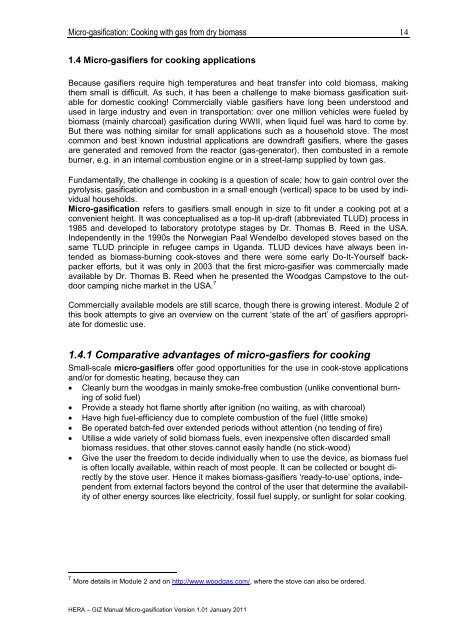Micro-gasification: Cooking with gas from biomass - Amper
Micro-gasification: Cooking with gas from biomass - Amper
Micro-gasification: Cooking with gas from biomass - Amper
You also want an ePaper? Increase the reach of your titles
YUMPU automatically turns print PDFs into web optimized ePapers that Google loves.
<strong>Micro</strong>-<strong><strong>gas</strong>ification</strong>: <strong>Cooking</strong> <strong>with</strong> <strong>gas</strong> <strong>from</strong> dry <strong>biomass</strong><br />
1.4 <strong>Micro</strong>-<strong>gas</strong>ifiers for cooking applications<br />
Because <strong>gas</strong>ifiers require high temperatures and heat transfer into cold <strong>biomass</strong>, making<br />
them small is difficult. As such, it has been a challenge to make <strong>biomass</strong> <strong><strong>gas</strong>ification</strong> suitable<br />
for domestic cooking! Commercially viable <strong>gas</strong>ifiers have long been understood and<br />
used in large industry and even in transportation: over one million vehicles were fueled by<br />
<strong>biomass</strong> (mainly charcoal) <strong><strong>gas</strong>ification</strong> during WWII, when liquid fuel was hard to come by.<br />
But there was nothing similar for small applications such as a household stove. The most<br />
common and best known industrial applications are downdraft <strong>gas</strong>ifiers, where the <strong>gas</strong>es<br />
are generated and removed <strong>from</strong> the reactor (<strong>gas</strong>-generator), then combusted in a remote<br />
burner, e.g. in an internal combustion engine or in a street-lamp supplied by town <strong>gas</strong>.<br />
Fundamentally, the challenge in cooking is a question of scale; how to gain control over the<br />
pyrolysis, <strong><strong>gas</strong>ification</strong> and combustion in a small enough (vertical) space to be used by individual<br />
households.<br />
<strong>Micro</strong>-<strong><strong>gas</strong>ification</strong> refers to <strong>gas</strong>ifiers small enough in size to fit under a cooking pot at a<br />
convenient height. It was conceptualised as a top-lit up-draft (abbreviated TLUD) process in<br />
1985 and developed to laboratory prototype stages by Dr. Thomas B. Reed in the USA.<br />
Independently in the 1990s the Norwegian Paal Wendelbo developed stoves based on the<br />
same TLUD principle in refugee camps in Uganda. TLUD devices have always been intended<br />
as <strong>biomass</strong>-burning cook-stoves and there were some early Do-It-Yourself backpacker<br />
efforts, but it was only in 2003 that the first micro-<strong>gas</strong>ifier was commercially made<br />
available by Dr. Thomas B. Reed when he presented the Wood<strong>gas</strong> Campstove to the outdoor<br />
camping niche market in the USA. 7<br />
Commercially available models are still scarce, though there is growing interest. Module 2 of<br />
this book attempts to give an overview on the current ‗state of the art‘ of <strong>gas</strong>ifiers appropriate<br />
for domestic use.<br />
1.4.1 Comparative advantages of micro-<strong>gas</strong>fiers for cooking<br />
Small-scale micro-<strong>gas</strong>ifiers offer good opportunities for the use in cook-stove applications<br />
and/or for domestic heating, because they can<br />
Cleanly burn the wood<strong>gas</strong> in mainly smoke-free combustion (unlike conventional burning<br />
of solid fuel)<br />
Provide a steady hot flame shortly after ignition (no waiting, as <strong>with</strong> charcoal)<br />
Have high fuel-efficiency due to complete combustion of the fuel (little smoke)<br />
Be operated batch-fed over extended periods <strong>with</strong>out attention (no tending of fire)<br />
Utilise a wide variety of solid <strong>biomass</strong> fuels, even inexpensive often discarded small<br />
<strong>biomass</strong> residues, that other stoves cannot easily handle (no stick-wood)<br />
Give the user the freedom to decide individually when to use the device, as <strong>biomass</strong> fuel<br />
is often locally available, <strong>with</strong>in reach of most people. It can be collected or bought directly<br />
by the stove user. Hence it makes <strong>biomass</strong>-<strong>gas</strong>ifiers ‗ready-to-use‘ options, independent<br />
<strong>from</strong> external factors beyond the control of the user that determine the availability<br />
of other energy sources like electricity, fossil fuel supply, or sunlight for solar cooking.<br />
7 More details in Module 2 and on http://www.wood<strong>gas</strong>.com/, where the stove can also be ordered.<br />
HERA – GIZ Manual <strong>Micro</strong>-<strong><strong>gas</strong>ification</strong> Version 1.01 January 2011<br />
14
















